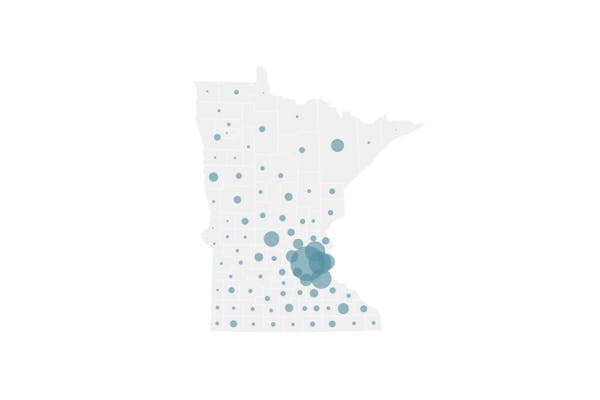State health officials urged Minnesotans to celebrate Halloween on Saturday and vote next Tuesday, but to take precautions with both to reduce the risk of exacerbating the COVID-19 pandemic.
The celebrated days come amid rising infections and deaths in the state, and a record number of Minnesotans hospitalized — 643 reported on Wednesday — for COVID-19. State infectious disease director Kris Ehresmann said people need to understand their personal risks before deciding how to participate in both.
"COVID is in our communities and all around the state," she said. "So getting together with even a relatively small group of people from outside your household is riskier than it was a month ago."
Voters who missed out on early balloting should try polling places at slower times on Election Day and should wear masks, health officials said. Those with mild sniffles can alert poll workers, who can take precautions such as sanitizing the voting booths afterward.
People at high risk of severe COVID-19 due to age or health history can request curbside voting at their polling places, and those quarantined due to viral exposures can have election agents deliver ballots to their doors.
COVID-19 is spread primarily through virus-carrying droplets from people 6 feet away or closer, and being that close to an infected person for 15 minutes is considered enough to put people at moderate risk.
While trick-or-treating exchanges don't last that long, and COVID-19 isn't spread as much through surface contact, Ehresmann said the sheer volume of encounters on a standard night of trick-or-treating puts people at risk.
"The multiple elements of that make that a higher-risk activity," she said. "If you went to one door and left, and didn't go to any others, that's one thing. But then when you're going door to door to door, that's concerning. And you're not only going door to door, you're taking things."
She recommended lower-risk activities such as watching scary movies at home, participating in backyard scavenger hunts or partaking in online costume contests. Moderate-risk activities include prepared treat bags for trick-or-treaters to pick up without touching anyone, while traditional trick-or-treating and Halloween parties are high risk.
Part of the concern comes from the volume of group activities and social gatherings that have sparked outbreaks and fueled the spread of the coronavirus that causes COVID-19.
State Health Commissioner Jan Malcolm said there have now been outbreaks linked to 71 weddings, and she said a recent one involving an outdoor service and indoor reception included someone who later died from COVID-19.
"The risk is real, and social settings such as celebrations and social gatherings of many, many types are helping to drive this pandemic," she said.
The state has now reported 2,387 COVID-19 deaths and 139,444 infections.
State officials received the latest White House status report on Minnesota Wednesday, and it listed 15 of the state's 87 counties in the "red zone" due to high infection rates. The state's current infection rate ranks 20th nationally.
Gov. Tim Walz earlier this week urged broader mask-wearing and social distancing to prevent Minnesota's infection rate from rising to the level of several neighboring states. North and South Dakota currently have the nation's highest rates of infections, and Wisconsin ranks fourth.
A Mayo Clinic Health System official on Wednesday said northwest Wisconsin is in a particularly "sobering" situation and is "facing a real possibility of overwhelming the hospital systems."
Mayo has started postponing nonemergency procedures at its medical center in Eau Claire, Wis., and is pulling workers from other hospitals and clinics due to local workers being infected or quarantined due to viral exposures, said Dr. Bobbie Gostout, Mayo Clinic Health System president. Nine Rochester nurses were diverted to Eau Claire to support ER and ICU care last weekend.
"The shift is having to make sure that we accommodate the unpredictable admissions with COVID infections — they arrive day and night, they're very sick, and the length of their hospital stay is much less predictable than some of the patients who typically occupy our beds," Gostout said.
While Minnesota's hospitals are busier now than they were during the first COVID-19 peak in May, they aren't under as much pressure.
The state's pandemic dashboard showed 166 COVID-19 patients in intensive care beds in Minnesota hospitals. However, only 1,074 of 1,483 immediately available ICU beds were occupied by patients with COVID-19 or unrelated medical concerns.
Part of the ICU occupancy surge in May was because hospitalized COVID-19 cases increased right as hospitals resumed more surgeries, which required patients to spend recovery time in intensive care.
Hospitals are in a better position than they were in May to deal with high COVID and non-COVID caseloads, but hospitals need public compliance with public health prevention strategies to stay that way, said Dr. Rahul Koranne of the Minnesota Hospital Association. Broader spread of COVID-19 will eventually infect health care workers, who then can't staff beds and treat patients until they have recovered or finished quarantines, he added.
"There is COVID fatigue for sure, there is distance fatigue for sure," he said, "but if we don't do the simple steps right now, it [leads to] a very predictable increase in community spread."
Koranne said he already voted by mail and will be celebrating Halloween at home with his family. Doors to closets and rooms will stand in as front doors to homes, and his 8-year-old twin boys and 10-year-old daughter will knock at each one to get candy.
"I am going to be Batman," Koranne said, "I think."
Staff Writer Christopher Snowbeck contributed to this report.
Jeremy Olson • 612-673-7744
New Minnesota GOP leaders seek peace with party's anti-establishment wing

Who is Republican Lisa Demuth, Minnesota's first House speaker of color?

Minnesota House GOP, Secretary of State Steve Simon return to Supreme Court
Supreme Court sides with DFL and Simon, says 68 House members needed for floor action

